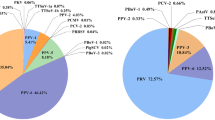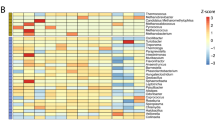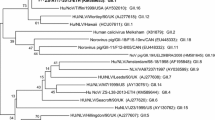Abstract
Domestic swine have been introduced by humans into a wide diversity of environments and have been bred in different production systems. This has resulted in an increased risk for the occurrence and spread of diseases. Although viromes of swine in intensive farms have been described, little is known about the virus communities in backyard production systems around the world. The aim of this study was to describe the viral diversity of 23 healthy domestic swine maintained in rural backyards in Morelos, Mexico, through collection and analysis of nasal and rectal samples. Next-generation sequencing was used to identify viruses that are present in swine. Through homology search and bioinformatic analysis of reads and their assemblies, we found that rural backyard swine have a high degree of viral diversity, different from those reported in intensive production systems or under experimental conditions. There was a higher frequency of bacteriophages and lower diversity of animal viruses than reported previously. In addition, sapoviruses, bocaparvoviruses, and mamastroviruses that had not been reported previously in our country were identified. These findings were correlated with the health status of animals, their social interactions, and the breeding/rearing environment (which differed from intensive systems), providing baseline information about viral communities in backyard swine.







Similar content being viewed by others
Availability of data and material
Sequences are available in GenBank with accession numbers MH490914, MH490915, MH490916, MH490912, MH490913, MH490911 and MH479904.
References
Lambin EF, Turner BL, Geist HJ et al (2001) The causes of land-use and land-cover change : moving beyond the myths. Glob Environ Chang 11:261–269. https://doi.org/10.1016/S0959-3780(01)00007-3
Patz JA, Daszak P, Tabor GM et al (2004) Unhealthy landscapes: policy recommendations on land use change and infectious disease emergence. Environ Health Perspect 112:1092–1098. https://doi.org/10.1289/EHP.6877
Cohen ML (1998) Resurgent and emergent disease in a changing world. Br Med Bull 54:523–532. https://doi.org/10.1093/oxfordjournals.bmb.a011707
Schultz-Cherry S, Olsen CW, Easterday BC (2011) History of Swine Influenza. In: Current topics in microbiology and immunology. Curr Top Microbiol Immunol, pp 21–27
Smith I, Wang LF (2013) Bats and their virome: an important source of emerging viruses capable of infecting humans. Curr Opin Virol 3:84–91. https://doi.org/10.1016/j.coviro.2012.11.006
Philbey AW, Kirkland PD, Ross AD et al (1998) An apparently new virus (family Paramyxoviridae) infectious for pigs, humans, and fruit bats. Emerg Infect Dis 4:269–271. https://doi.org/10.3201/eid0402.980214
Bowden TR, Westenberg M, Wang LF et al (2001) Molecular characterization of menangle virus, a novel paramyxovirus which infects pigs, fruit bats, and humans. Virology 283:358–373. https://doi.org/10.1006/viro.2001.0893
Wang LF, Hansson E, Yu M et al (2007) Full-length genome sequence and genetic relationship of two paramyxoviruses isolated from bat and pigs in the Americas. Arch Virol 152:1259–1271. https://doi.org/10.1007/s00705-007-0959-4
Cuevas-Romero JS, Blomstrom AL, Berg M (2015) Molecular and epidemiological studies of Porcine rubulavirus infection—an overview. Infect Ecol Epidemiol 5:1–8. https://doi.org/10.3402/iee.v5.29602\r29602[pii]
Yaiw KC, Crameri G, Wang L et al (2007) Serological evidence of possible human infection with tioman virus, a newly described paramyxovirus of bat origin. J Infect Dis 196:884–886. https://doi.org/10.1086/520817
Yaiw KC, Bingham J, Crameri G et al (2008) Tioman virus, a paramyxovirus of bat origin, causes mild disease in pigs and has a predilection for lymphoid tissues. J Virol 82:565–568. https://doi.org/10.1128/JVI.01660-07
Hause BM, Duff JW, Scheldt A, Anderson G (2016) Virus detection using metagenomic sequencing of swine nasal and rectal swabs. J Swine Heal Prod 24:304–308
Sachsenröder J, Twardziok S, Hammerl JA et al (2012) Simultaneous identification of DNA and RNA viruses present in pig faeces using process-controlled deep sequencing. PLoS One. https://doi.org/10.1371/journal.pone.0034631
Shan T, Li L, Simmonds P et al (2011) The fecal virome of pigs on a high-density farm. J Virol 85:11697–11708. https://doi.org/10.1128/JVI.05217-11
Lager KM, Ng TF, Bayles DO et al (2012) Diversity of viruses detected by deep sequencing in pigs from a common background. J Vet Diagn Investig 24:1177–1179. https://doi.org/10.1177/1040638712463212
Gallardo Nieto JL, Villamar Angula L, Barrera Wadgymar MA (2006) Situación actual y perspectiva de la producción de carne de porcino en México 2006
Wiethoelter AK, Beltrán-Alcrudo D, Kock R, Mor SM (2015) Global trends in infectious diseases at the wildlife–livestock interface. Proc Natl Acad Sci 112:9662–9667. https://doi.org/10.1073/pnas.1422741112
CEA (2014) Programa estatal hídrico de Morelos 2014 - 2018. 110
INEGI IN de EG e I (2016) Mapa Digital de México. http://gaia.inegi.org.mx/mdm6/?v=bGF0OjE4LjYyNDAwLGxvbjotOTkuMDQ3Mjgsejo2LGw6YzQwN3xjNDE3fGMxMDJ8YzEwMHxjMzUw&layers=c401,c404,c407,c410,c417,c418. Accessed 21 Jun 2018
Djikeng A, Halpin R, Kuzmickas R et al (2008) Viral genome sequencing by random priming methods. BMC Genomics 9:5. https://doi.org/10.1186/1471-2164-9-5
Afgan E, Baker D, Batut B et al (2018) The Galaxy platform for accessible, reproducible and collaborative biomedical analyses: 2018 update. Nucleic Acids Res 46:W537–W544. https://doi.org/10.1093/nar/gky379
Zerbino DR (2011) Using the Velvet de novo assembler for short-read seqeuncig technologies. Curr Protoc Bioinform. https://doi.org/10.1002/0471250953.bi1105s31.Using
Zerbino DR, Birney E (2008) Velvet: Algorithms for de novo short read assembly using de Bruijn graphs. Genome Res 18:821–829. https://doi.org/10.1101/gr.074492.107
Kumar S, Stecher G, Li M et al (2018) MEGA X: molecular evolutionary genetics analysis across computing platforms. Mol Biol Evol 35:1547–1549. https://doi.org/10.1093/molbev/msy096
Saitou N, Nei M (1987) The neighbor-joining method: a new method for reconstructing phylogenetic trees. Mol Biol Evol 4:406–425. https://doi.org/10.1093/oxfordjournals.molbev.a040454
Tamura K, Nei M, Kumar S (2004) Prospects for inferring very large phylogenies by using the neighbor-joining method. Proc Natl Acad Sci 101:11030–11035. https://doi.org/10.1073/pnas.0404206101
Hsieh TC, Ma KH, Chao A (2016) iNEXT: an R package for rarefaction and extrapolation of species diversity (Hill numbers). Methods Ecol Evol 7:1451–1456. https://doi.org/10.1111/2041-210X.12613
Chao A, Ma KH, Hsieh TC (2016) iNEXT (iNterpolation and EXTrapolation) Online. Program and User’s Guide published at http://chao.stat.nthu.edu.tw/wordpress/software_download/.30043:1–14. https://doi.org/10.13140/RG.2.2.25777.79200. Accessed 6 July 2018
SAGARPA (2011) ACUERDO mediante el cual se dan a conocer en los Estados Unidos Mexicanos las enfermedades y plagas exóticas y endémicas de notificación obligatoria de los animales terrestres y acuáticos. D Of la Fed 38:38–85
Sachsenröder J, Twardziok SO, Scheuch M, Johne R (2014) The general composition of the faecal virome of pigs depends on age, but not on feeding with a probiotic bacterium. PLoS One 9:15–22. https://doi.org/10.1371/journal.pone.0088888
Zhang B, Tang C, Yue H et al (2014) Viral metagenomics analysis demonstrates the diversity of viral flora in piglet diarrhoeic faeces in China. J Gen Virol 95:1603–1611. https://doi.org/10.1099/vir.0.063743-0
Wang D (2020) 5 challenges in understanding the role of the virome in health and disease. PLoS Pathog 16:e1008318. https://doi.org/10.1371/journal.ppat.1008318
Biggs PM (1985) Infectious animal disease and its control. Philos Trans R Soc Lond B Biol Sci 310:259–274
Tung J, Barreiro LB, Burns MB et al (2015) Social networks predict gut microbiome composition in wild baboons. Elife 2015:1–18. https://doi.org/10.7554/eLife.05224
Amimo JO, El Zowalaty ME, Githae D et al (2016) Metagenomic analysis demonstrates the diversity of the fecal virome in asymptomatic pigs in East Africa. Arch Virol 161:887–897. https://doi.org/10.1007/s00705-016-2819-6
Colbère-Garapin F, Martin-Latil S, Blondel B et al (2007) Prevention and treatment of enteric viral infections: possible benefits of probiotic bacteria. Microbes Infect 9:1623–1631. https://doi.org/10.1016/j.micinf.2007.09.016
Modi SR, Lee HH, Spina CS, Collins JJ (2013) Antibiotic treatment expands the resistance reservoir and ecological network of the phage metagenome. Nature 499:219–222. https://doi.org/10.1038/nature12212
Ogilvie LA, Bowler LD, Caplin J et al (2013) Genome signature-based dissection of human gut metagenomes to extract subliminal viral sequences. Nat Commun 4:2420. https://doi.org/10.1038/ncomms3420
Chiappetta CM, Cibulski SP, Lima FES et al (2017) Molecular detection of circovirus and adenovirus in feces of fur seals (Arctocephalus spp.). EcoHealth 14:69–77. https://doi.org/10.1007/s10393-016-1195-8
Oba M, Katayama Y, Naoi Y et al (2017) Discovery of fur seal feces-associated circular DNA virus in swine feces in Japan. J Vet Med Sci 79:1664–1666. https://doi.org/10.1292/jvms.16-0642
Breitbart M, Delwart E, Rosario K et al (2017) ICTV virus taxonomy profile: circoviridae. J Gen Virol 98:1997–1998. https://doi.org/10.1099/jgv.0.000871
Ge X, Li J, Peng C et al (2011) Genetic diversity of novel circular ssDNA viruses in bats in China. J Gen Virol 92:2646–2653. https://doi.org/10.1099/vir.0.034108-0
Wang H, Li S, Mahmood A et al (2018) Plasma virome of cattle from forest region revealed diverse small circular ssDNA viral genomes. Virol J 15:11. https://doi.org/10.1186/s12985-018-0923-9
Li L, Kapoor A, Slikas B et al (2010) Multiple diverse circoviruses infect farm animals and are commonly found in human and chimpanzee feces. J Virol 84:1674–1682. https://doi.org/10.1128/JVI.02109-09
Chiba S, Sakuma Y, Kogasaka R et al (1979) An outbreak of gastroenteritis associated with calicivirus in an infant home. J Med Virol 4:249–254
Reuter G, Zimsek-Mijovski J, Poljsak-Prijatelj M et al (2010) Incidence, diversity, and molecular epidemiology of sapoviruses in swine across Europe. J Clin Microbiol 48:363–368. https://doi.org/10.1128/JCM.01279-09
Green KY, Ando T, Balayan MS et al (2000) Taxonomy of the caliciviruses. J Infect Dis 181(Suppl):S322–S330. https://doi.org/10.1086/315591
Scheuer KA, Oka T, Hoet AE et al (2013) Prevalence of porcine Noroviruses, molecular characterization of emerging porcine sapoviruses from finisher swine in the United States, and unified classification scheme for sapoviruses. J Clin Microbiol 51:2344–2353. https://doi.org/10.1128/JCM.00865-13
Wang QH, Han MG, Funk JA et al (2005) Genetic diversity and recombination of porcine sapoviruses. J Clin Microbiol 43:5963–5972. https://doi.org/10.1128/JCM.43.12.5963-5972.2005
Martella V, Lorusso E, Banyai K et al (2008) Identification of a porcine calicivirus related genetically to human sapoviruses. J Clin Microbiol 46:1907–1913. https://doi.org/10.1128/JCM.00341-08
Zhou F, Sun H, Wang Y (2014) Porcine bocavirus: Achievements in the past five years. Viruses 6:4946–4960. https://doi.org/10.3390/v6124946
Luo Z, Roi S, Dastor M et al (2011) Multiple novel and prevalent astroviruses in pigs. Vet Microbiol 149:316–323. https://doi.org/10.1016/j.vetmic.2010.11.026
Blomström A-L, Widén F, Hammer A-S et al (2010) Detection of a novel astrovirus in brain tissue of mink suffering from shaking mink syndrome by use of viral metagenomics. J Clin Microbiol 48:4392–4396. https://doi.org/10.1128/JCM.01040-10
Quan P-L, Wagner TA, Briese T et al (2010) Astrovirus ENCEPHALITIS IN BOY WITH X-LINKED AGAMMAGLOBULINEMIA. Emerg Infect Dis 16:918–925. https://doi.org/10.3201/eid1606.091536
Hause BM, Padmanabhan A, Pedersen K, Gidlewski T (2016) Feral swine virome is dominated by single-stranded DNA viruses and contains a novel Orthopneumovirus which circulates both in feral and domestic swine. J Gen Virol 97:2090–2095. https://doi.org/10.1099/jgv.0.000554
Acknowledgements
We thank Omar Ríos Bello, Omar Maldonado Pineda, José López Reyeros, Julio José Barrón Rodríguez, and Francisco A. Rosas Rodríguez for their help in field work. We also thank Carlos Cabello and José Eduardo Márquez García for their support during the sequencing work at the INER, and Jairo Betancourt for his help in translation of this text.
Funding
This work was supported by the National Institute of Research in Forestry, Agriculture and Livestock (INIFAP) and the Mexican Council for Science and Technology (CONACyT) [scholarship 219623].
Author information
Authors and Affiliations
Contributions
Conceived by Rodrigo J. Barrón-Rodríguez and Elizabeht Loza-Rubio. Performed research: Rodrigo J. Barrón-Rodríguez, Edith Rojas-Anaya, José A.I. Romero-Espinosa, Joel A. Vázquez-Pérez and Moisés Cortés-Cruz. Analyzed the data: Rodrigo J. Barrón-Rodríguez, Jorge T. Ayala-Sumuano, Gary García-Espinosa. Wrote the paper: Rodrigo J. Barrón-Rodríguez, Elizabeth Loza-Rubio, Moisés Cortés-Cruz and Gary García-Espinosa.
Corresponding author
Ethics declarations
Conflict of interest
The authors declare that they have no conflict of interest.
Ethics approval
The care, handling and sampling of animals for this study were conducted in accordance with the guidelines issued by the Secretary of Agriculture and Rural Development (Spanish acronym, SADER). The experiment was approved by the Institutional Committee for Care and Use of Experimental Animals (Spanish acronym, CICUAE) of the Faculty of Veterinary Medicine and Animal Science at the Universidad Nacional Autónoma de México (UNAM) by protocol DC-2016/2-2.
Code availability
Available upon request from the authors.
Additional information
Handling Editor: Ana Cristina Bratanich.
Publisher's Note
Springer Nature remains neutral with regard to jurisdictional claims in published maps and institutional affiliations.
Supplementary Information
Below is the link to the electronic supplementary material.
Rights and permissions
About this article
Cite this article
Barrón-Rodríguez, R.J., Rojas-Anaya, E., Ayala-Sumuano, J.T. et al. Swine virome on rural backyard farms in Mexico: communities with different abundances of animal viruses and phages. Arch Virol 166, 475–489 (2021). https://doi.org/10.1007/s00705-020-04894-y
Received:
Accepted:
Published:
Issue Date:
DOI: https://doi.org/10.1007/s00705-020-04894-y




